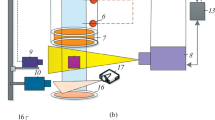Abstract
Various mechanisms of formation and growth of water microdrops in the atmosphere include attachment of water molecules to them, coagulation and coalescence processes, and growth of drops during the rain caused by the gravitation. Condensed water cannot be formed under the conditions of standard atmosphere, it results from mixing of humid streams with cold air. Atmospheric water microdrops form the clouds, and their contribution to the atmospheric radiative flux toward the Earth is about 30%. The Mie theory for scattering of infrared radiation on liquid water droplets is represented that uses the measured optical parameters for liquid water. Then, basing on the energetic balance of the Earth and its atmosphere, it is possible to determine the relative mass of condensed water, which is of the order of 1% of the total mass of atmospheric water and is several times less than the analysis of atmospheric electricity suggests.






Similar content being viewed by others
REFERENCES
R. R. Braham, J. Meteorol. 9, 227 (1952).
http://en.wikipedia.org/wiki/water-circle.
http://water.usgs.gov/edu/watercyrcleatmosphere.html.
A. Baumgartner and E. Reichel, The World Water Balance (Elsevier, Amsterdam, 1975).
I. A. Shiklomanov, in Water in Crisis: A Guide to the World’s Fresh Water Resources, Ed. by P. H. Gleick (Oxford Univ. Press, Oxford, 1993), p. 13.
I. A. Shiklomanov and J. C. Rodda, World Water Resources at the Beginning of the Twenty-First Century (Cambridge Univ. Press, Cambridge, 2003).
R. W. Healy, T. C. Winter, J. W. Labaugh, and O. L. Franke, U. S. Geol. Surv. Circ., No. 1308 (Reston, VI, 2007).
http://www.climate4you.com/GreenhouseGasses.htm.
http://atmospheres.gsfc.nasa.gov/meso/index.php.
S. E. Reynolds, M. Brook, and M. F. Gourley, J. Meteorol. 14, 426 (1957).
B. M. Smirnov, Phys. Usp. 57, 1041 (2014).
B. M. Smirnov, Microphysics of Atmospheric Phenomena, Springer Atmospheric Series (Springer, Switzerland, 2017).
S. Twomey, Atmospheric Aerosols (Elsevier, Amsterdam, 1977).
H. G. Houghton, Physical Metereology (MIT, Cambridge, 1985).
S. Twomey, Atmos. Environ. A 25, 2435 (1991).
B. M. Smirnov, Nanoclusters and Microparticles in Gases and Vapors (De Gruyter, Berlin, 2012).
B. M. Smirnov, Cluster Processes in Gases and Plasmas (Wiley, Berlin, 2010).
Ya. B. Zeldovich, Zh. Eksp. Teor. Fiz. 12, 525 (1942).
F. F. Abraham, Homogeneous Nucleation Theory (Academic, New York, 1974).
L. D. Landau and E. M. Lifshitz, Course of Theoretical Physics, Vol. 9: Statistical Physics, Part 2 (Nauka, Moscow, 1978; Pergamon, New York, 1980).
I. Gutzow and J. Schmelzer, The Vitreous State (Springer, Berlin, 1995).
W. Ostwald, Zs. Phys. Chem. 22, 289 (1897).
W. Ostwald, Zs. Phys. Chem. 34, 495 (1900).
U. S. Standard Atmosphere (U. S. Government Printing Office, Washington, 1976).
https://tamino.wordpress.com/2010/08/08/urban-wet-island/.
http://www.c3headlines.com/greehouse-gases-atmosphereco2methanewater-vapor.
http://www.c3headlines.com/natural-negativepositive-feedback.
https://en.wikipedia.org/wiki/Electromagnetic-absorption-by-water.
http://www1.lsbu.ac.uk/water/water-vibrational-spectrum.html.
C. M. R. Platt, Quart. J. R. Meteorol. Soc. 102, 553 (1976).
L. D. Landau and E. M. Lifshitz, Course of Theoretical Physics, Vol. 8: Electrodynamics of Continuous Media (Nauka, Moscow, 1982; Pergamon, Oxford, 1984).
G. Mie, Ann. Phys. 330, 377 (1908).
B. M. Smirnov, Clusters and Small Particles in Gases and Plasmas (Springer, New York, 1999).
H. D. Downing and D. W. Williams, J. Geophys. Res. 80, 1656 (1975).
B. M. Smirnov, High Temp. 57, 573 (2019).
Understanding Climate Change (Nat. Acad. Sci., Washington, 1975).
V. P. Krainov and B. M. Smirnov, Atomic and Molecular Radiative Processes (Springer, Berlin, 2019).
K. Ya. Kondratyev, Radiation in the Atmosphere (Academic, New York, 1969).
K. Ya. Kondratev, Radiation Processes in the Atmosphere (World Meteorol. Organization, Geneva, 1972).
K. N. Liou, An Introduction to Atmospheric Radiation (Academic, Amsterdam, 2002).
K. Ya. Kondratyev, L. S. Ivlev, V. F. Krapivin, and C. A. Varotsos, Atmospheric Aerosol Properties. Formation, Processes, and Impacts (Springer Praxis, Chichester, 2006).
M. L. Salby, Physics of the Atmosphere and Climate (Cambridge Univ. Press, Cambridge, 2012).
https://www.cfa.harvard.edu/.
http://www.hitran.iao.ru/home.
Author information
Authors and Affiliations
Corresponding author
Rights and permissions
About this article
Cite this article
Smirnov, B.M. Atmospheric Processes Involving Condensed Water. Phys. Solid State 62, 24–29 (2020). https://doi.org/10.1134/S106378342001031X
Received:
Revised:
Accepted:
Published:
Issue Date:
DOI: https://doi.org/10.1134/S106378342001031X



